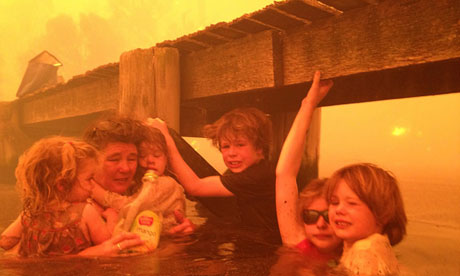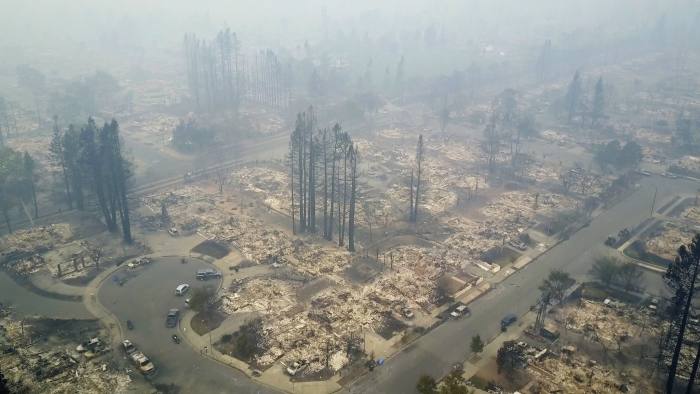
Family taking refuge under a bridge from a firestorm that erupted in Tasmania in January, 2013.
The raging wildfires that swept Tasmania in January, 2013 are still fresh in the mind of many Aussies, even more so now as they behold the outbreak of monstrous wildfires in California wine country. Let's note here the northern California wine country had for long been considered safe from wildfires that ravaged the rest of the state (WSJ, 'Deadly California Wildfires Rip Through Once Safe Areas, yesterday, p. A1)
The wildfire that's erupted and now claimed 21 lives and charred 115,000 acres with 20,000 evacuated has given residents of wine country a wake up call. As of yesterday, as the WSJ piece reported, 15 wineries had been damaged by the fire and at least 2,000 homes and businesses were destroyed. And the toll is mounting as the fire remains uncontained.

Devastated scene near Santa Rosa, California
As usual we hear the standard patter of meteorological factors, i.e. "Diablo winds", dry conditions, high pressure region in place, but little or nothing of the climate related aspect- namely how global warming has enhanced the frequency and intensity of wildfires which is why they have become much larger, more unpredictable and difficult to control.
The WSJ piece notes (p. A4):
"A recent study from the University of California- Merced found that the fire season in the western U.S. was more than 80 days longer on average - between 2003 and 2012 - than it was between 1973 and 1982. because the climate has grown hotter, "
As if in recognition of this, Ken Pimlott - chief of CAL-FIRE told the Journal:
"These are the fires that we are going to experience into the future."
And he is correct because as we near and then pass the runaway greenhouse threshold we will see such firestorms across the planet and almost continuously.
At the time of the Tasmanian wildfires, Tim Flannery (author of ‘The Weather Makers’) noted in addition:
“Records are broken from time to time but record breaking weather is becoming more common as the climate shifts. Only strong preventative action, with deep and swift cuts in emissions this decade, can stabilize the climate and halt the trend toward more intense and extreme weather.”
“Records are broken from time to time but record breaking weather is becoming more common as the climate shifts. Only strong preventative action, with deep and swift cuts in emissions this decade, can stabilize the climate and halt the trend toward more intense and extreme weather.”
Following the Tasmanian fires the report of the Australian Commission stated that the number of record hot days in Australia had doubled since the 1980s with the summer of 2012/13 featuring the hottest summer, hottest month and hottest day on record. By comparison, in 2009, Melbourne experienced three days with temperatures of 43 C (109 F) or higher.
Around the same time, The U.S. projections from a U.S. Forest Service Report on Climate weren't any better, e.g. http://www.treesearch.fs.fed.us/pubs/42610
As it notes,
"By the end of the 21st century, forest ecosystems in the United States will differ from those of today as a result of changing climate. Although increases in temperature, changes in precipitation, higher atmospheric concentrations of carbon dioxide (CO2), and higher nitrogen (N) deposition may change ecosystem structure and function, the most rapidly visible and most significant short-term effects on forest ecosystems will be caused by altered disturbance regimes. For example, wildfires, insect infestations, pulses of erosion and flooding, and drought-induced tree mortality are all expected to increase during the 21st century."
As climate scientist James Hansen has observed, rising concentrations of CO2 are at the center of the greenhouse dynamic. The temperature of the planet is currently out of balance by 0.6W/ m2 and this is almost entirely due to the annual rate of CO2 concentrations increasing. (It is now at 409 ppm) Every increase in CO2 concentration by 2 ppm increases the radiative heating effect by 2 W/ m2.
Go to climate research centers such as at the Geophysical Institute of the University of Alaska- Fairbanks and you will find atmospheric science researchers examining ice core samples dating from nearly 600,000 yrs. ago showing rising CO2 concentrations coinciding with much warmer periods.
The current concentration of 409 ppm is the highest it's been in some 800,000 years. As it continues to increase with the increasing injection of CO2 into the atmosphere (much of it now from the wildfires themselves) we will reach the point where the temperatures are so hot and conditions so dire that wildfires raging across the planet will be the norm.
What we're seeing now in California is but a preview of what's to come, likely by the first decade of the 22nd century.
Note: Some scientists have argued that no runaway greenhouse effect will ever come into play, and others that a CO2 concentration of at least 30,000 ppm will be necessary. The late Carl Sagan - who first postulated the runaway greenhouse on Venus - had adamantly disputed any such nonsense in his interview with Ted Turner on CNN in 1990.
Note: Some scientists have argued that no runaway greenhouse effect will ever come into play, and others that a CO2 concentration of at least 30,000 ppm will be necessary. The late Carl Sagan - who first postulated the runaway greenhouse on Venus - had adamantly disputed any such nonsense in his interview with Ted Turner on CNN in 1990.
No comments:
Post a Comment